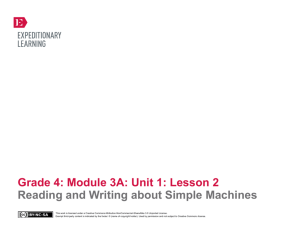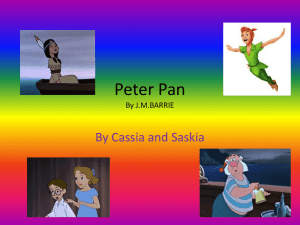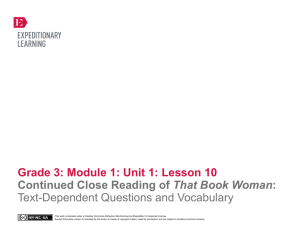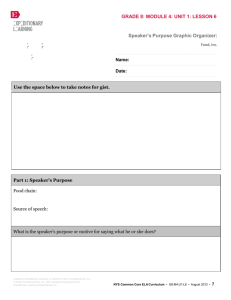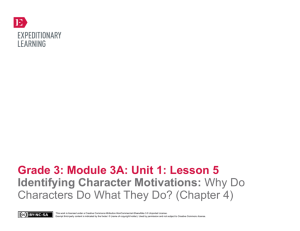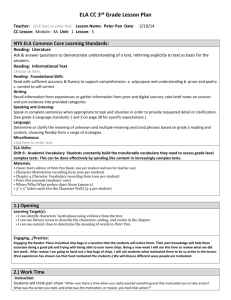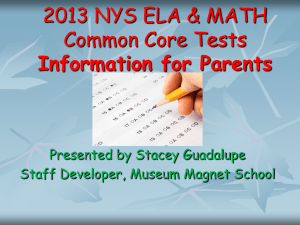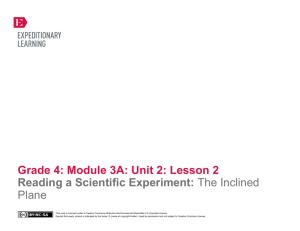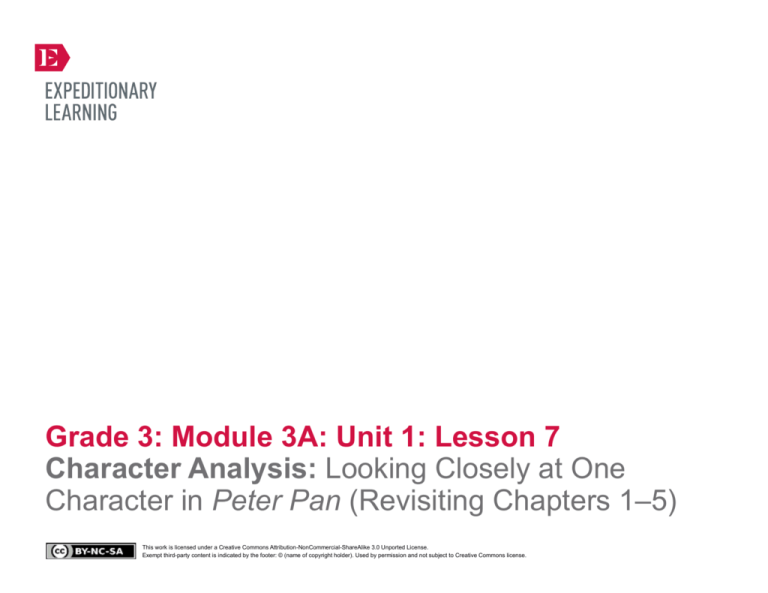
Grade 3: Module 3A: Unit 1: Lesson 7
Character Analysis: Looking Closely at One
Character in Peter Pan (Revisiting Chapters 1–5)
This work is licensed under a Creative Commons Attribution-NonCommercial-ShareAlike 3.0 Unported License.
Exempt third-party content is indicated by the footer: © (name of copyright holder). Used by permission and not subject to Creative Commons license.
GRADE 3: MODULE 3A: UNIT 1: LESSON 7
Character Analysis:
Looking Closely at One Character in Peter Pan (Revisiting Chapters 1–5)
Long-Term Targets Addressed (Based on NYSP12 ELA CCLS)
I can describe the characters in a story (traits, motivations, feelings). (RL.3.3)
I can use literary terms to describe parts of a story or poem (e.g., chapter, scene, stanza). (RL.3.5)
I can write an opinion piece that supports a point of view with reasons. (W.3.1)
Supporting Learning Targets
Ongoing Assessment
• I can describe a character from Peter Pan by creating a character analysis.
• Character Analysis recording form Exit ticket
• I can write an opinion about a character using evidence to support my opinion.
Copyright © 2013 by Expeditionary Learning, New York, NY. All Rights Reserved.
NYS Common Core ELA Curriculum • G3:M3A:U1:L7 • June 2014 •
1
GRADE 3: MODULE 3A: UNIT 1: LESSON 7
Character Analysis:
Looking Closely at One Character in Peter Pan (Revisiting Chapters 1–5)
Agenda
Teaching Notes
1. Opening
• This lesson helps students review and synthesize key teaching points about character from Lessons 4, 5,
and 6. In this lesson, students do not read a new chapter. Instead they revisit old chapters to synthesize
information about a single character. Students will need to read Chapter 6 during another time in the
day or for homework. At the start of Lesson 8, they will create the Where/Who/What anchor chart for
Chapter 6.
A. Unpacking the Learning Targets (5 minutes)
2. Work Time
A. Mini Lesson: Creating a Character Analysis:
Revisiting Mr. Darling (15 minutes)
B. Creating a Character Analysis: Looking Closely at
Wendy or Tinker Bell (20 minutes)
C. Small Group Discussion: Character Analysis for
Wendy or Tinker Bell (10 minutes)
• In advance: Prepare the Character Analysis anchor chart (see example in supporting materials).
• In advance: Choose the trait/action/motivation to use for the anchor chart. Be prepared to help support
students who are struggling by giving them a specific chapter or page number to limit their search for
evidence.
3. Closing and Assessment
A. Exit Ticket: Opinion Writing (10 minutes)
4. Homework
A. Reread your favorite section of Chapter 6, either in
front of a mirror, or to a family member. How is your
fluency? Practice reading a single paragraph out loud
a few of times until it sounds smooth and shows
expression. Share who you believe the most
important character in this story is so far, and why
you think this.
Copyright © 2013 by Expeditionary Learning, New York, NY. All Rights Reserved.
NYS Common Core ELA Curriculum • G3:M3A:U1:L7 • June 2014 •
2
GRADE 3: MODULE 3A: UNIT 1: LESSON 7
Character Analysis:
Looking Closely at One Character in Peter Pan (Revisiting Chapters 1–5)
Lesson Vocabulary
Materials
describe, character, analysis, traits,
motivations, actions, evidence, opinion
• Character Analysis anchor chart (new; teacher-created; one for display)
• Character Analysis recording form (one per student)
• Classic Starts edition of Peter Pan (one per student and one for teacher use)
• Exit Ticket: Opinion Writing (one per student)
• Exit Ticket: Opinion Writing (Supported Version) (optional; for students needing more support)
Meeting Students’ Needs
Opening
A. Unpacking the Learning Targets (5 minutes)
• Congratulate the students for all the important work and deep thinking they have been doing about characters so far in their
reading of Peter Pan. Tell them that today they will have the opportunity to show all their learning by working with their
groups to create a character analysis for a character from the book.
• Review today’s learning target with students. Discuss the word analysis as the close study of a something, figuring out its
most important qualities. Connect this to the root word analyze. To analyze something means to examine something
carefully. Invite students to share what they will be doing today in their own words.
Copyright © 2013 by Expeditionary Learning, New York, NY. All Rights Reserved.
NYS Common Core ELA Curriculum • G3:M3A:U1:L7 • June 2014 •
3
GRADE 3: MODULE 3A: UNIT 1: LESSON 7
Character Analysis:
Looking Closely at One Character in Peter Pan (Revisiting Chapters 1–5)
Work Time
Meeting Students’ Needs
A. Mini Lesson: Creating a Character Analysis: Revisiting Mr. Darling (15 minutes)
• Remind students of the three aspects of character they have studied so far: traits, actions, and motivations. Tell them that
today they will be character detectives: investigating one character closely to find his or her traits, motivations, and
important actions, and collecting evidence to support their thinking. This lesson is a review of their learning about character
so far. However, by thinking of all three aspects of character at once, they are combining all of their learning to read, think,
write, and talk about one character in a deeper way.
• Using a simple sentence frame for
the use of evidence will support
students in connecting their ideas to
evidence from the text: “I know Mr.
Darling is __________ [character
trait] because he
_______________ [specific text
evidence].
• Direct students’ attention to the Character Analysis anchor chart. Tell them that they will be working together to think
deeply about Mr. Darling, specifically his traits, motivations, and actions.
• Briefly review the meaning of the word trait. Ask students to Think-Pair-Share the following question:
* “What kind of character is Mr. Darling? How could we describe him using a character trait word?”
• Encourage students to work with a partner, flipping through the Peter Pan text and recording forms to look for parts
involving Mr. Darling. Invite whole class shares. Listen for words such as: jealous, protective, cold. Select one important
character trait word for Mr. Darling and write it in the “Character Traits” column of the Character Analysis anchor chart.
• Using total participation techniques,
such as cold call or equity sticks,
encourages a wider range of voices
in whole class shares.
• Remind students how important it is to support their ideas with evidence from the text. Again, ask the students to ThinkPair-Share:
* “What specific evidence in the book can you find to show that Mr. Darling shows this character trait?”
• Give students a couple of minutes to work with a partner, finding a specific place in the text where Mr. Darling exhibits the
chosen character trait. Ask students to give a silent signal, such as a thumbs-up, once they have found evidence. Invite whole
class shares. Consider praising students as effective “detectives” for finding the evidence they needed. Write the evidence in
the “Evidence from the Text” column of the Character Analysis anchor chart.
• Repeat this process with Mr. Darling’s motivations, and with Mr. Darling’s important actions, linking this with how his
action moved the story forward.
Copyright © 2013 by Expeditionary Learning, New York, NY. All Rights Reserved.
NYS Common Core ELA Curriculum • G3:M3A:U1:L7 • June 2014 •
4
GRADE 3: MODULE 3A: UNIT 1: LESSON 7
Character Analysis:
Looking Closely at One Character in Peter Pan (Revisiting Chapters 1–5)
Meeting Students’ Needs
Work Time (continued)
B. Creating a Character Analysis: Looking Closely at Wendy or Tinker Bell (20 minutes)
• Distribute the Character Analysis recording form. Tell students that they will now become character detectives with
their reading partner, looking closely at either Wendy or Tinker Bell. Remind students that, like all good detectives, they
should be searching in their books for the best evidence to support their thinking.
• Ideally, there will be an even number of partnerships studying Wendy and Tinker Bell, so partnerships can form small
groups to share their thinking about these two characters.
• Circulate and support students as they complete the Character Analysis recording forms.
C. Small Group Discussion: Character Analysis for Wendy and Tinker Bell (10 minutes)
• Combine one pair of students who focused on Wendy with one group who focused on Tinker Bell. Ask students to share their
Character Analysis recording form with the other group, going step-by-step through traits, motivations, and actions, as well
as the evidence they chose from the text to support their thinking.
• Tell students that it is important that they look closely at one another’s work, giving feedback about the ideas they had and
the evidence they chose. Tell students that they need to know about both characters, since they will write about them in their
exit ticket.
• Give students time to discuss their character analysis.
Copyright © 2013 by Expeditionary Learning, New York, NY. All Rights Reserved.
NYS Common Core ELA Curriculum • G3:M3A:U1:L7 • June 2014 •
5
GRADE 3: MODULE 3A: UNIT 1: LESSON 7
Character Analysis:
Looking Closely at One Character in Peter Pan (Revisiting Chapters 1–5)
Closing and Assessment
Meeting Students’ Needs
A. Exit Ticket (10 minutes)
• Distribute the Exit Ticket: Opinion Writing to each student. Briefly frame this writing, reading the prompt aloud if
necessary.
• Select students will benefit from an
alternate recording form to guide
their thinking and writing (see
supporting materials).
• Give students ten minutes to write. Collect their writing as formative assessment.
• Tell students that in the next lesson they will be completing a character analysis, identical to the one from this lesson, as a
mid-unit assessment.
• Consider using a simple sentence
frame to help students in their
thinking and forming of an opinion:
“________________ [character]
is more important because
__________________
[evidence].”
Homework
Meeting Students’ Needs
• Reread your favorite section of Chapter 6, either in front of a mirror, or to a family member. How is your fluency? Practice
reading a single paragraph out loud a few times until it sounds smooth and shows expression. Share who you believe the
most important character in this story is so far, and why you think this.
Note: Lesson 8 is the mid-unit assessment, in which students will complete a character analysis for the main character, Peter
Pan. Review today’s activity as a formative assessment, identifying students who may need additional practice or support.
Copyright © 2013 by Expeditionary Learning, New York, NY. All Rights Reserved.
NYS Common Core ELA Curriculum • G3:M3A:U1:L7 • June 2014 •
6
Grade 3: Module 3A: Unit 1: Lesson 7
Supporting Materials
This work is licensed under a Creative Commons Attribution-NonCommercial-ShareAlike 3.0 Unported License.
Exempt third-party content is indicated by the footer: © (name of copyright holder). Used by permission and not subject to Creative Commons license.
GRADE 3: MODULE 3A: UNIT 1: LESSON 7
Character Analysis Recording Form
Name:
Date:
Learning target: I can describe the characters in a story (traits, motivations, feelings). (RL.3.3)
Character Name:
Character Traits:
What is a character trait that best describe this character?
What evidence from the text supports your thinking?
Character Trait
Evidence from the Text
Character Motivations:
What motivates this character so far in the story?
What evidence from the text supports your thinking?
Character Motivation
Copyright © 2013 by Expeditionary Learning, New York, NY. All Rights Reserved.
Evidence from the Text
NYS Common Core ELA Curriculum • G3:M3A:U1:L7 • June 2014 •
8
GRADE 3: MODULE 3A: UNIT 1: LESSON 7
Character Analysis Recording Form
Character Actions:
What is an important action that this character has taken so far in the story?
How did the action move the story forward in some way?
Character Action
Evidence from the Text
Now that you have looked closely at the traits, motivations, and actions of this character, how do you
think this character is important to the story Peter Pan? Use evidence to support your thinking.
Copyright © 2013 by Expeditionary Learning, New York, NY. All Rights Reserved.
NYS Common Core ELA Curriculum • G3:M3A:U1:L7 • June 2014 •
9
GRADE 3: MODULE 3A: UNIT 1: LESSON 7
Exit Ticket: Opinion Writing
Name:
Date:
Which character has been more important to the story so far, Wendy or Tinker Bell?
Which one has done more to move the story forward?
What evidence do you have to support your thinking?
(Hint: There is no right answer to this question. But be sure to think carefully about each character’s
actions, and how those actions moved the story forward.)
Copyright © 2013 by Expeditionary Learning, New York, NY. All Rights Reserved.
NYS Common Core ELA Curriculum • G3:M3A:U1:L7 • June 2014 •
10
GRADE 3: MODULE 3A: UNIT 1: LESSON 7
Exit Ticket: Opinion Writing
(Supported Version)
Name:
Date:
Which character has been more important to the story so far, Wendy or Tinker Bell?
Why do you think this? Provide evidence, or reasons, to support your thinking:
Copyright © 2013 by Expeditionary Learning, New York, NY. All Rights Reserved.
NYS Common Core ELA Curriculum • G3:M3A:U1:L7 • June 2014 •
11

